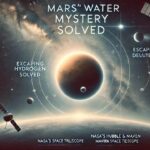NASA, asteroid 2024 NF, near-Earth asteroid, asteroid collision, space agency, Apollo asteroids, asteroid impact, space news, celestial events, NASA warning, asteroid monitoring, asteroid defense
NASA has issued a warning about the gigantic asteroid 2024 NF, set to pass near Earth at a staggering speed of 73,054 kilometers per hour. Discover the potential risks and the efforts to monitor and mitigate the impact of near-Earth asteroids.

NASA ALERT: Gigantic Asteroid To Pass Near Earth At Speed Of 73,000 KMPH – Will It Hit Our Planet?
The American space agency, NASA, has issued a warning about an enormous asteroid named 2024 NF. This astronomical body is on a path to pass close to Earth at a staggering speed of 73,054 kilometers per hour. The warning has raised concerns among scientists and researchers who are closely monitoring the asteroid due to its significant size and velocity.
Gigantic Asteroid To Pass Near Earth
NASA’s alert about the asteroid 2024 NF has garnered significant attention worldwide. This asteroid, part of the Apollo group, is expected to pass by Earth within 4.8 million kilometers on July 17 at approximately 11:28 UTC (4:58 PM IST). Measuring around 220 feet (67 meters) in size, 2024 NF poses a potential threat due to its large size and high speed. Researchers are particularly focused on ensuring that its trajectory remains on a path that keeps it from colliding with our planet.
Will 2024 NF Collide With Earth?
The good news is that 2024 NF is not expected to hit Earth. Despite its enormous size and rapid speed, current trajectories indicate that the asteroid will pass safely by our planet. However, the close proximity and the asteroid’s characteristics have prompted scientists to consider the possible consequences if such an asteroid were to collide with Earth. The aftermath of such a collision could be catastrophic, with effects varying depending on the impact location and the composition of the asteroid.
Apollo Asteroids
The 2024 NF asteroid belongs to the Apollo group, a class of near-Earth asteroids named after the first discovered asteroid of this group, 1862 Apollo. These asteroids have orbits that intersect with Earth’s path, making close approaches to our planet possible. Due to their potential threat, Apollo asteroids are of great interest to scientists who study their trajectories and physical properties to better understand the risks they pose.
Potential Consequences of a Collision
If an asteroid of the size and speed of 2024 NF were to collide with Earth, the impact could unleash a force equivalent to multiple nuclear explosions. The resulting destruction would depend on various factors, including the location of the impact and the asteroid’s composition. An oceanic impact could generate massive tsunamis, while a terrestrial impact could ignite widespread fires and create powerful shock waves. Such an event could also lead to significant changes in global climate, affecting the environment for an extended period.
Monitoring and Mitigating Asteroid Risks
Space agencies like NASA are dedicated to monitoring asteroids such as 2024 NF to assess potential risks and develop strategies to mitigate the effects of any possible collisions. This involves tracking the asteroids’ paths, studying their physical properties, and devising plans to deflect or disrupt any that pose a significant threat. These efforts are crucial in protecting Earth from potential asteroid impacts and ensuring the safety of our planet.
The Importance of Continuous Monitoring
As 2024 NF approaches its closest point to Earth on July 17, the event serves as a reminder of the importance of continuous monitoring and research of celestial bodies. While the asteroid’s current trajectory suggests that there is no immediate danger, its close pass highlights the need for vigilance in tracking near-Earth objects. Ongoing efforts to monitor and understand asteroids help scientists prepare for potential future threats and develop measures to protect our planet.
Advancements in Asteroid Detection and Defense
In recent years, significant advancements have been made in the detection and defense against asteroids. NASA and other space agencies have developed sophisticated telescopes and tracking systems that allow for the early identification of potentially hazardous asteroids. Additionally, initiatives like the Double Asteroid Redirection Test (DART) mission aim to test methods of deflecting asteroids from collision courses with Earth. These advancements represent crucial steps in safeguarding our planet from asteroid impacts.
The Role of International Cooperation
Addressing the threat of asteroid impacts requires international cooperation and collaboration. Space agencies around the world share data and work together to track and study near-Earth objects. This collaborative approach enhances our ability to detect potential threats early and develop coordinated response strategies. By pooling resources and expertise, the global community can better prepare for and mitigate the risks posed by asteroids.
Public Awareness and Education
Public awareness and education are essential components of asteroid impact preparedness. Informing the public about the risks and the measures being taken to address them helps build support for space research and defense initiatives. Additionally, educating people about what to do in the event of an asteroid impact can save lives and reduce panic. NASA and other space agencies regularly provide updates and educational materials to keep the public informed about near-Earth objects and the efforts to monitor and mitigate their risks.
Future Research and Exploration
The study of asteroids is an ongoing field of research that continues to evolve. Future missions aim to explore asteroids more closely, gathering data that can improve our understanding of their composition and behavior. This information is crucial for developing effective defense strategies against potential impacts. Missions like OSIRIS-REx, which has collected samples from the asteroid Bennu, provide valuable insights that contribute to our knowledge of these celestial bodies.
Conclusion
The approach of asteroid 2024 NF serves as a reminder of the potential threats posed by near-Earth objects. While this particular asteroid is not expected to collide with Earth, its close pass underscores the importance of continued monitoring and research. Space agencies like NASA play a critical role in tracking and studying asteroids, developing strategies to mitigate the risks they pose, and ensuring the safety of our planet. Through international cooperation, advancements in technology, and public education, we can enhance our preparedness for potential asteroid impacts and protect Earth from future threats.
As we keep an eye on asteroid 2024 NF and other near-Earth objects, the efforts to understand and monitor these celestial bodies are more important than ever. By staying vigilant and investing in research and technology, we can continue to safeguard our planet from the dangers that lurk in space.
Read More
- NASA Postpones Spacewalk Outside ISS Due to Spacesuit Discomfort Issue:
- NASA Webb Telescope Reveals New Insights into the Origins of the Crab Nebula
- NASA GOLD Mission Discovers Surprising Alphabetical Shapes in Earth
- Joe Engle: NASA Astronaut and US Air Force Pilot Who Made History










